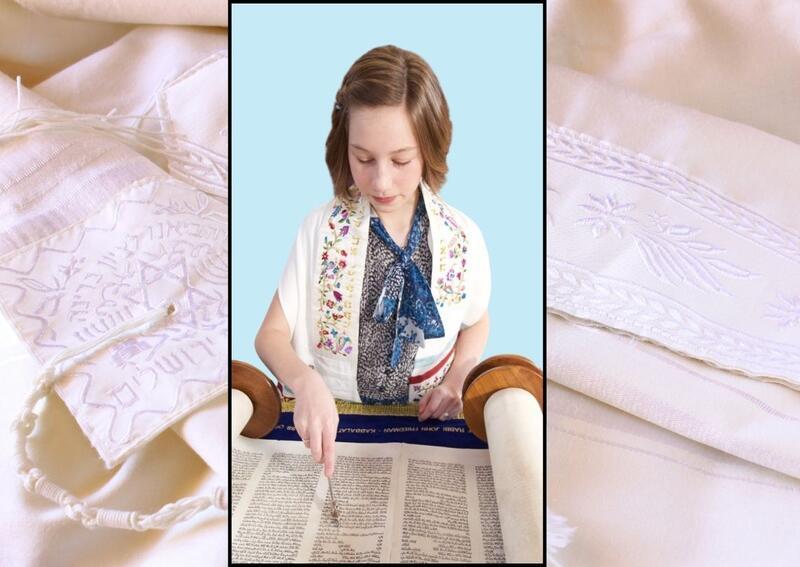Wrapped in the Tallit of Jewish Matriarchs
I skim my hands over my tallit, getting ready to recite the ancient prayer and place it on my shoulders. It's Rosh Hashanah, the start of the new year. The morning feels fresh and alive, the sun shining brightly through my synagogue’s big, glass windows. As I wait for services to begin, my hands travel over the subtle stripes of royal blue and crimson red, the intricate embroidery of birds and flowers, the delicately knotted tzitzit on the ends, and the names of the four matriarchs on each corner of this fabric. I put the tallit over my head and read the Hebrew verse from Song of Solomon emblazoned on top: “Let me hear your voice, for your voice is fair and your face is lovely.” The service begins. My synagogue’s female cantor begins to sing Hinei Mah Tov, and the president makes her annual remarks; later, I play my violin on the bimah and my sister reads from the Torah.
The tallit resting on my shoulders is the one I received at my bat mitzvah. Though feminism has been everywhere as I’ve grown up (raised by two parents devoted to equality and social awareness, and as the third of three sisters,) this tallit was the first thing related to Judaism and feminism that was totally and completely mine. When my parents stood with me at my bat mitzvah four years ago and placed the tallit over my head, I felt for the first time that I was becoming my own person: an independent Jewish woman and feminist.
For me, being an independent Jew and an independent feminist have always felt like two inextricable identities, bound up in each other in more contexts than one: in the social justice initiatives at my temple, the sermons of my rabbi, the Jewish affinity group at my school, and the insightful conversations about misogyny at the dinner table at home. Part of growing up, however—part of growing into an empowered woman, Jew, and human—is realizing that personal experiences aren’t universal truths. Judaism’s interactions with feminism are complex; the history is emotional and varied, and there’s still so much progress to be made. Not only does my tallit symbolize a coming-of-age moment and the comfort of being part of a community of strong women, but it’s also taught me this difficult and uncomfortable truth.
Yair Emanuel, a Judaica artist who lives in Israel, designed my prayer shawl, which is titled “The Garden of Eden.” He created it specifically for the organization Women of the Wall. As described by the group, Women of the Wall (Neshot Hakotel) is a collective of “Jewish women from Israel and around the world, who strive to achieve the right to wear prayer shawls, pray and read from the Torah collectively and out loud at the Western Wall (Kotel) in Jerusalem.” My mother chose this tallit for me because she wanted this fierce spirit to propel me forward in my journey with Judaism, to raise questions about our complicated religion and traditions.
Jews have prayed towards Jerusalem for over 2,000 years, with the Kotel at the forefront of our spiritual imagination and yearning. Yet, even after this longing became a reality in 1967, not all of us have gotten to experience it fully. Women aren’t allowed to wear religious items like tallit and tefillin at the Wall, and there are countless stories, videos, and images of police arresting and detaining female protesters who assert their Jewish identity in the area. This injustice epitomizes a disorienting tension between feminism and contemporary Judaism: What does it mean to hold onto tradition while celebrating female autonomy, pluralism, and liberalism at the same time? I learned about this dilemma because many of these protesters wear the same tallit as I do.
My tallit both centers my most fundamental values and tremendously expands my worldview. It embodies the lifelong commitment to feminism and Judaism that has defined my childhood, my family, and my identity, reminding me of the incredible community of women at my synagogue. At the same time, the tallit has opened my eyes to uncomfortable truths and dilemmas to which I still don’t have the answers. But I’m convinced that it’s supposed to be that way: that there aren’t supposed to be clear-cut answers to these difficult questions. The things that remind us of growing up, of empowerment, also tend to be the things that confuse us; that remind us of injustice; that make us question what it means to be Jewish in 2021.
In the midst of this uncertainty—perhaps even because of it—my tallit brings me peace. Every time I read the names of Sarah, Leah, Rebecca, and Rachel embroidered in the corners and every time I say the prayer, I feel reminded of the first time I took a step to merge my Jewish and feminist identities. I feel urgency to grapple with difficult questions, if not to find the exact answers.
Sitting with my prayer book—listening to powerful women lead one of the most important services of the year, wearing my tallit from a feminist group on my shoulders—I am both figuratively and physically wrapped in the power and the comfort of the Jewish matriarchs who have come before me, and the Jewish matriarchs who are here right now. In the midst of this uncertainty—or, again, perhaps even because of it—I feel like I’m becoming the Jewish woman I want to be.
This piece was written as part of JWA’s Rising Voices Fellowship.








Your piece is so genuine and beautifully written Amelia!